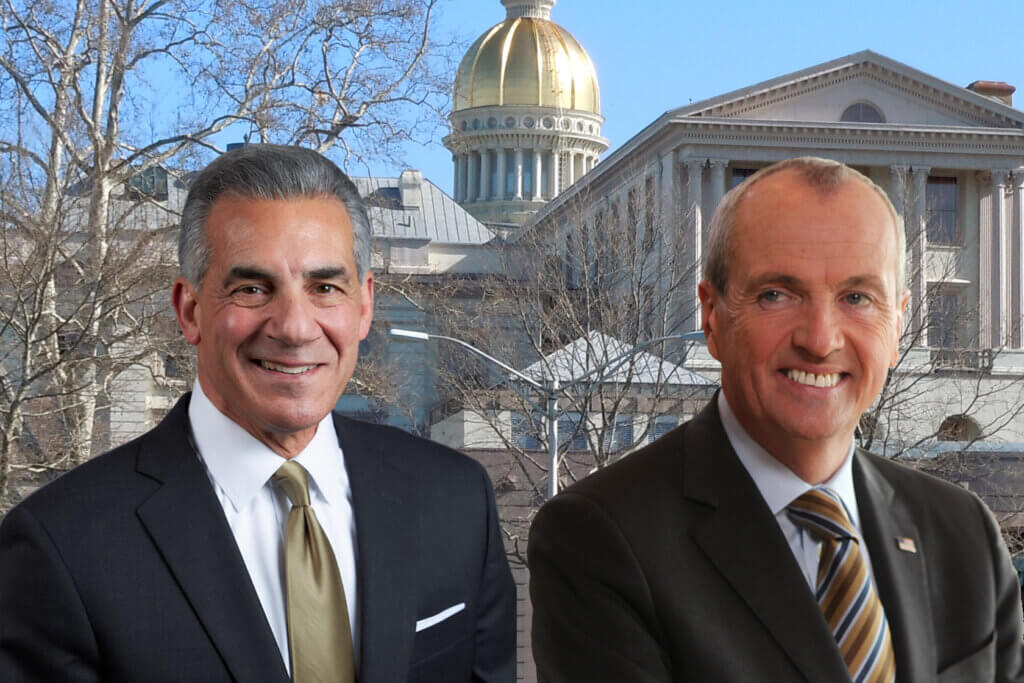West Long Branch, NJ – Phil Murphy maintains a sizable lead over Jack Ciattarelli, although the margin has narrowed over the past two months, according to the final Monmouth (“Mon-muth”) University Poll of the New Jersey governor’s race. A top issue for voters in the current poll is taxes, an area where Ciattarelli, the Republican challenger, has a decided advantage. However, Murphy is more trusted across a wider range of policy areas. Even though the Covid pandemic has diminished as a voter concern as education has risen as a priority, the Democratic incumbent maintains a lead because he has a clear edge on both issues. The poll also finds that Garden State opinion of President Joe Biden – who appeared at a groundbreaking event in Kearny this week – has dropped into negative territory.
Half (50%) of registered voters support Murphy while 39% back Ciattarelli. This 11-point margin is a slight decrease for the incumbent from results in September (13 points, 51% to 38%) and August (16 points, 52% to 36%). Support levels among various demographic groups are generally in line with where they stood last month. The most notable exception is the senior vote (age 65+), which has gone from a 53% to 37% lead for Murphy in September to a smaller 48% to 43% lead in the current poll.
Murphy continues to hold a large advantage among black voters (83% to 6%) as well as Latinos, Asians and other voters of color (63% to 22%). He also has a small lead among white college graduates (49% to 43%), but trails Ciattarelli among white voters without a bachelor’s degree (35% to 55%).
“We’ve had a couple of debates and a slew of advertising since the last Monmouth poll. Ciattarelli has chipped away at Murphy’s lead but hasn’t delivered the knockout he needs,” said Patrick Murray, director of the independent Monmouth University Polling Institute.
A range of probabilistic electorate models* show Murphy with a lead between 8 and 14 points depending on the scenario. These margins ranged from 9 to 19 points in prior polls. A traditional likely voter model similar to one used by Monmouth during the 2017 gubernatorial campaign gives the incumbent an 11-point lead (51% to 40%). [The traditional “cut-off” model includes registered voters who cast a ballot in at least 2 of the last 4 general elections and report being “certain” or “likely” to vote, or have already voted.] Ciattarelli actually has a lead among those who intend to vote on Election Day, ranging anywhere from 5 points (47% to 42%) to 12 points (51% to 39%) depending on the turnout model. However, Murphy enjoys a large 63% to 26% margin among voters who have already cast their ballots or who intend to vote early.
| NEW JERSEY: ELECTORATE SCENARIOS | ||||||
| Governor vote choice: | Registered voters | Range of probabilistic models | Traditional LV model | |||
| October | ||||||
| Murphy | 50% | 50% | 52% | 51% | ||
| Ciattarelli | 39% | 42% | 38% | 40% | ||
| September | ||||||
| Murphy | 51% | 50% | 52% | 53% | ||
| Ciattarelli | 38% | 41% | 38% | 40% | ||
| August | ||||||
| Murphy | 52% | 51% | 55% | 54% | ||
| Ciattarelli | 36% | 40% | 36% | 37% | ||
| Source: Monmouth University Poll Oct. 21-25, 2021 | ||||||
Both major party candidates command the support of their respective partisan bases; 93% of self-identified Democrats back Murphy and 87% of self-identified Republicans back Ciattarelli. Self-described independents are evenly divided (41% for Ciattarelli and 40% for Murphy). Another way to look at partisan support is based on how voters are actually registered. Murphy is backed by 75% of registered Democrats and Ciattarelli is backed by 75% of registered Republicans. Pundits tend to point to New Jersey’s large group of “unaffiliated” voters – those who are not registered with any political party – as a key to winning New Jersey elections. This year, those voters tilt toward the incumbent (46% to 40%).
“Even if we figure in potential error margins for these partisan group results, Ciattarelli cannot win this race based on registered Republicans and unaffiliated voters alone. That outcome would require a pretty sizable collapse of Democratic turnout,” said Murray.
New Jersey issue priorities have been shuffled a bit over the past few months. Back in August, the pandemic and taxes were the top concerns named by New Jersey voters. Now, no single issue dominates. From a list of seven different policy areas asked about in the poll, “taxes” emerges, nominally, as the top issue (27%); followed by jobs and the economy (20%), schools and education (16%), and the pandemic (15%). The remaining issues register in the single digits: i.e. crime (7%), abortion (5%), and transportation infrastructure (4%).
Ciattarelli has an advantage over Murphy on being trusted more to handle taxes (39% to 29%), but Murphy has a larger edge on education (42% to 27% for Ciattarelli) and the pandemic (45% to 26%), as well as abortion (39% to 23%) and transportation (36% to 24%). The two candidates are about evenly matched on handling jobs and the economy (34% Murphy to 33% Ciattarelli) and crime (32% Ciattarelli to 30% Murphy).
“Ciattarelli’s attack on Murphy as being out of touch on taxes has resonated with some voters, but not enough to change the overall issue picture for this campaign. Even though concerns about the pandemic have lessened, the shift toward education policy basically produces the same benefit for Murphy. He is viewed as the better candidate on both issues,” said Murray.
Murray added the following on comparisons to the Virginia election: “There are some interesting parallels in the issue environment for the country’s two gubernatorial races this year. There has been a swing in both states from voters’ being concerned with the pandemic to a greater focus on schools. In Virginia, the Republican candidate took advantage of a gaffe by the Democrat to shift the conversation from Covid safety protocols to parental input on the curriculum. In New Jersey, though, the Murphy camp has maintained control by tying the two issues together in an ad attacking Ciattarelli’s positions on school mask and vaccine mandates. This probably helped preserve the incumbent’s advantage in both areas.”
A key metric that differentiates the New Jersey election from the Virginia race is that the partisan enthusiasm gap, while evident, is nowhere near as stark. Overall, 27% of Garden State voters say they are more enthusiastic about this gubernatorial election than usual, including 38% of self-identified Republicans and 24% of self-identified Democrats. This is slightly larger than September’s enthusiasm gap (34% Republican to 25% Democrat). However, in Monmouth’s poll of Virginia voters taken last week, 34% of all voters in that state were more enthusiastic, with a much larger gap between Republicans (49%) and Democrats (26%).
There have also been some partisan fluctuations in self-reported motivation. Over the past three months, about two-thirds of all registered voters have consistently said they are very motivated to vote in the election for governor (67% in the current poll). In August, more voters who identify as Republican (77%) than Democrat (65%) reported being very motivated. This gap flipped in September (76% Democrat to 73% Republican) but has flipped back again in the current poll (77% Republican to 72% Democrat), although the GOP advantage on this metric is not as large as it was in August.
“The partisan difference in voter motivation seems to be related to the national mood as much as anything going on in the New Jersey campaign. Republican enthusiasm may help narrow the gap a bit down the stretch, but it’s not clear that it can close it in the next few days,” said Murray.
Looking at the national picture, President Joe Biden’s job performance rating in the Garden State has dropped into net negative territory – 43% approve and 49% disapprove. His prior ratings from New Jersey voters showed him with majority approval levels (51% in August and 55% in May). By contrast, Murphy has maintained a positive rating as governor since the pandemic began. He currently stands at 52% approve and 39% disapprove, a result that is basically in line with his ratings throughout this year. About one-third of New Jersey voters (32%) say Murphy has been able to get more things done in Trenton than Biden has in Washington. Just 7% say Murphy has done less while nearly half (47%) say the two men have been able to get the same amount done.
“The president’s visit on Monday may have done more to boost Biden rather than Murphy when you look at their approval ratings,” said Murray.
In terms of overall impression of the two gubernatorial candidates, just under half (45%) of the state’s voters have a favorable view of Murphy and 37% have an unfavorable opinion, with 18% giving no answer. Ciattarelli registers a net positive opinion of 37% favorable and 25% unfavorable – but that also means about 4 in 10 voters (39%) still have no opinion of the Republican nominee (although this is down from 50% in September and 61% in August). This finding is not unusual for a non-incumbent. Republican Kim Guadagno in 2017 (39%) and Democrat Barbara Buono in 2013 (40%) recorded similar levels of “no opinion” in Monmouth’s final polls of those contests. Even Murphy was relatively unfamiliar to voters when he won office four years ago (34% no opinion). One needs to go back to Republican Chris Christie in 2009 to find a challenger with better name recognition (just 19% no opinion).
The Monmouth University Poll was conducted by telephone from October 21 to 25, 2021 with 1,000 New Jersey registered voters. The question results in this release have a margin of error of +/- 3.1 percentage points. The poll was conducted by the Monmouth University Polling Institute in West Long Branch, NJ.
* Monmouth’s electorate models for the 2021 election are not forecasts. They are designed to present a range of reasonable outcomes based on voter intentions at this moment. Monmouth tests a variety of models where each registered voter is assigned a probabilistic weight between 0 and 1, based primarily on past voting history, with adjustments for self-reported likelihood to vote, motivation and other factors. Further adjustments are applied to the aggregate sample based on turnout propensities among different demographic groups (e.g. by race, gender, education). The two scenarios included in this report show the extreme ends of the range of possible outcomes from the model testing.
QUESTIONS AND RESULTS
(* Some columns may not add to 100% due to rounding.)
1.If the election for Governor was today, would you vote for Jack Ciattarelli the Republican, Phil Murphy the Democrat, or some other candidate? [NAMES WERE ROTATED] [If UNDECIDED: If you had to vote for one of the following candidates at this moment, who do you lean toward – Jack Ciattarelli or Phil Murphy?] [Note: Voters who report already casting their ballots were asked, “In the election for governor, did you vote for…”]
| TREND: REGISTERED VOTERS (with leaners) | Oct. 2021 | Sept. 2021 | Aug. 2021 |
| Jack Ciattarelli | 39% | 38% | 36% |
| Phil Murphy | 50% | 51% | 52% |
| Other candidate | 1% | 2% | 2% |
| (VOL) No one | 1% | <1% | 1% |
| (VOL) Undecided | 9% | 9% | 9% |
| (n) | (1,000) | (804) | (810) |
[QUESTIONS 2 & 3 WERE ROTATED]
2.Is your general impression of Jack Ciattarelli very favorable, somewhat favorable, somewhat unfavorable, or very unfavorable, or do you have no opinion?
| TREND: REGISTERED VOTERS | Oct. 2021 | Sept. 2021 | Aug. 2021 |
| Very favorable | 15% | 10% | 8% |
| Somewhat favorable | 22% | 21% | 18% |
| Somewhat unfavorable | 10% | 9% | 5% |
| Very unfavorable | 15% | 10% | 7% |
| No opinion | 39% | 50% | 61% |
| (n) | (1,000) | (804) | (810) |
3.Is your general impression of Phil Murphy very favorable, somewhat favorable, somewhat unfavorable, or very unfavorable, or do you have no opinion?
| TREND: REGISTERED VOTERS | Oct. 2021 | Sept. 2021 | Aug. 2021 | TREND: | Oct. 2021 | Sept. 2021 | Aug. 2021 | May 2021 | Apr. 2018 | July 2017 |
| Very favorable | 18% | 21% | 18% | Favorable | 45% | 48% | 48% | 50% | 41% | 29% |
| Somewhat favorable | 27% | 27% | 30% | |||||||
| Somewhat unfavorable | 12% | 11% | 10% | Unfavorable | 37% | 37% | 33% | 36% | 28% | 12% |
| Very unfavorable | 25% | 26% | 23% | |||||||
| No opinion | 18% | 16% | 19% | No opinion | 18% | 16% | 19% | 14% | 31% | 59% |
| (n) | (1,000) | (804) | (810) | (n) | (1,000) | (804) | (810) | (661) | (632) | (758) |
4.Which one of the following issues is most important to you in deciding your vote for governor? [ITEMS WERE ROTATED]
| REGISTERED VOTERS | Oct. 2021 |
| The Covid pandemic | 15% |
| Jobs and the economy | 20% |
| Taxes | 27% |
| Crime | 7% |
| Education and schools | 16% |
| Transportation infrastructure | 4% |
| Abortion | 5% |
| (VOL) Other, none of these | 6% |
| (VOL) No answer | 1% |
| (n) | (1,000) |
[QUESTIONS 5-11 WERE ROTATED]
5.Who do you trust more on handling the Covid pandemic – Jack Ciattarelli or Phil Murphy, or both equally? [NAMES WERE ROTATED]
| TREND: REGISTERED VOTERS | Oct. 2021 | Sept. 2021 | Aug. 2021 |
| Jack Ciattarelli | 26% | 23% | 21% |
| Phil Murphy | 45% | 50% | 46% |
| Both equally | 18% | 17% | 17% |
| (VOL) Neither | 4% | 5% | 6% |
| (VOL) Don’t know | 6% | 6% | 9% |
| (n) | (1,000) | (804) | (810) |
6.Who do you trust more on jobs and the economy – Jack Ciattarelli or Phil Murphy, or both equally? [NAMES WERE ROTATED]
| TREND: REGISTERED VOTERS | Oct. 2021 | Sept. 2021 | Aug. 2021 |
| Jack Ciattarelli | 33% | 32% | 27% |
| Phil Murphy | 34% | 39% | 35% |
| Both equally | 24% | 19% | 22% |
| (VOL) Neither | 3% | 3% | 6% |
| (VOL) Don’t know | 6% | 7% | 10% |
| (n) | (1,000) | (804) | (810) |
7.Who do you trust more on taxes – Jack Ciattarelli or Phil Murphy, or both equally? [NAMES WERE ROTATED]
| TREND: REGISTERED VOTERS | Oct. 2021 | Sept. 2021 | Aug. 2021 |
| Jack Ciattarelli | 39% | 39% | 30% |
| Phil Murphy | 29% | 33% | 29% |
| Both equally | 20% | 17% | 22% |
| (VOL) Neither | 5% | 4% | 8% |
| (VOL) Don’t know | 6% | 8% | 12% |
| (n) | (1,000) | (804) | (810) |
8.Who do you trust more on handling crime – Jack Ciattarelli or Phil Murphy, or both equally? [NAMES WERE ROTATED]
| TREND: REGISTERED VOTERS | Oct. 2021 | Sept. 2021 |
| Jack Ciattarelli | 32% | 30% |
| Phil Murphy | 30% | 32% |
| Both equally | 28% | 28% |
| (VOL) Neither | 3% | 3% |
| (VOL) Don’t know | 8% | 7% |
| (n) | (1,000) | (804) |
9.Who do you trust more on education and schools – Jack Ciattarelli or Phil Murphy, or both equally? [NAMES WERE ROTATED]
| REGISTERED VOTERS | Oct. 2021 |
| Jack Ciattarelli | 27% |
| Phil Murphy | 42% |
| Both equally | 22% |
| (VOL) Neither | 2% |
| (VOL) Don’t know | 6% |
| (n) | (1,000) |
10.Who do you trust more on transportation infrastructure – Jack Ciattarelli or Phil Murphy, or both equally? [NAMES WERE ROTATED]
| REGISTERED VOTERS | Oct. 2021 |
| Jack Ciattarelli | 24% |
| Phil Murphy | 36% |
| Both equally | 28% |
| (VOL) Neither | 4% |
| (VOL) Don’t know | 8% |
| (n) | (1,000) |
11.Who do you trust more on the issue of abortion – Jack Ciattarelli or Phil Murphy, or both equally? [NAMES WERE ROTATED]
| REGISTERED VOTERS | Oct. 2021 |
| Jack Ciattarelli | 23% |
| Phil Murphy | 39% |
| Both equally | 20% |
| (VOL) Neither | 5% |
| (VOL) Don’t know | 12% |
| (n) | (1,000) |
[QUESTIONS 12 & 13 WERE ROTATED]
12.Are Jack Ciattarelli’s political views in line or out of step with most New Jerseyans, or are you not sure?
| TREND: REGISTERED VOTERS | Oct. 2021 | Sept. 2021 | Aug. 2021 |
| In line | 19% | 16% | 13% |
| Out of step | 21% | 17% | 15% |
| Not sure | 60% | 68% | 73% |
| (n) | (1,000) | (804) | (810) |
13.Are Phil Murphy’s political views in line or out of step with most New Jerseyans, or are you not sure?
| TREND: REGISTERED VOTERS | Oct. 2021 | Sept. 2021 | Aug. 2021 |
| In line | 33% | 35% | 32% |
| Out of step | 24% | 24% | 22% |
| Not sure | 43% | 41% | 46% |
| (n) | (1,000) | (804) | (810) |
14.Do you approve or disapprove of the job Joe Biden is doing as president?
| TREND: REGISTERED VOTERS | Oct. 2021 | Aug. 2021 | May 2021 |
| Approve | 43% | 51% | 55% |
| Disapprove | 49% | 41% | 40% |
| (VOL) No opinion | 8% | 9% | 5% |
| (n) | (1,000) | (810) | (661) |
15.Do you approve or disapprove of the job Phil Murphy is doing as governor?
TREND: REGISTERED VOTERS | Oct. 2021 | Sept. 2021 | Aug. 2021 | May 2021 | April 2020 | Sept. 2019 | Feb. 2019 | April 2018 |
| Approve | 52% | 52% | 54% | 57% | 72% | 40% | 42% | 43% |
| Disapprove | 39% | 38% | 36% | 36% | 21% | 41% | 43% | 30% |
| (VOL) No opinion | 9% | 10% | 10% | 7% | 7% | 19% | 16% | 27% |
| (n) | (1,000) | (804) | (810) | (661) | (635) | (651) | (549) | (632) |
16.Regardless of where you stand on their policies, if you compare the Murphy administration in Trenton to the Biden administration in Washington – has Murphy been able to get more things done than Biden, fewer things done than Biden, or about the same amount as Biden?
| REGISTERED VOTERS | Oct. 2021 |
| More things done | 32% |
| Fewer things done | 7% |
| About the same amount | 47% |
| (VOL) Don’t know | 15% |
| (n) | (1,000) |
17.How will you vote this year – in person on Election Day, in person at an early voting location, or by mail ballot? [If ALREADY VOTED: How did you vote this year…?]
| TREND: REGISTERED VOTERS | Oct. 2021 | Sept. 2021 | Aug. 2021 |
| In person on Election Day | 58% | 54% | 54% |
| In person at an early voting location | 8% | 6% | 5% |
| By mail ballot | 19% | 35% | 36% |
| Already voted in person | 1% | n/a | n/a |
| Already voted by mail | 10% | n/a | n/a |
| (VOL) Won’t vote at all | 1% | 0% | 0% |
| (VOL) Don’t know | 2% | 4% | 5% |
| (n) | (1,000) | (804) | (810) |
18.How motivated are you to vote in the election for governor – very motivated, somewhat motivated, or not that motivated?
| TREND: REGISTERED VOTERS | Oct. 2021 | Sept. 2021 | Aug. 2021 |
| Very motivated | 67% | 67% | 65% |
| Somewhat motivated | 22% | 24% | 26% |
| Not that motivated | 10% | 8% | 9% |
| (VOL) Don’t know | 1% | 1% | 0% |
| (n) | (1,000) | (804) | (810) |
19.Compared to past elections for governor, are you more enthusiastic than usual, less enthusiastic, or about the same as past elections?
| TREND: REGISTERED VOTERS | Oct. 2021 | Sept. 2021 | Aug. 2021 |
| More enthusiastic | 27% | 27% | 27% |
| Less enthusiastic | 10% | 11% | 9% |
| About the same | 61% | 61% | 63% |
| (VOL) Don’t know | 2% | 2% | 1% |
| (n) | (1,000) | (804) | (810) |
METHODOLOGY
The Monmouth University Poll was sponsored and conducted by the Monmouth University Polling Institute from October 21 to 25, 2021 with a statewide random sample of 1,000 New Jersey voters drawn from a list of registered voters. This includes 280 contacted by a live interviewer on a landline telephone and 720 contacted by a live interviewer on a cell phone, in English. Monmouth is responsible for all aspects of the survey design, data weighting and analysis. The full sample is weighted for party registration, age, gender, race, education, and region based on state voter registration list information and U.S. Census information (CPS 2018 supplement). Data collection support provided by Braun Research (field) and Aristotle (voter sample). For results based on the full voter sample, one can say with 95% confidence that the error attributable to sampling has a maximum margin of plus or minus 3.1 percentage points (unadjusted for sample design). Sampling error can be larger for sub-groups (see table below). In addition to sampling error, one should bear in mind that question wording and practical difficulties in conducting surveys can introduce error or bias into the findings of opinion polls.
NJ Regions (by county)
North – Bergen, Essex, Hudson, Morris, Passaic, Sussex, Union, Warren
Central – Hunterdon, Mercer, Middlesex, Monmouth, Somerset
South – Atlantic, Burlington, Camden, Cape May, Cumberland, Gloucester, Ocean, Salem
| DEMOGRAPHICS (weighted) |
| REGISTERED VOTERS |
| Party Registration |
| 24% Republican |
| 40% Democrat |
| 36% Other/none |
| Self-Reported Party ID |
| 24% Republican |
| 42% Independent |
| 34% Democrat |
| 48% Male |
| 52% Female |
| 23% 18-34 |
| 22% 35-49 |
| 29% 50-64 |
| 26% 65+ |
| 64% White, non-Hispanic |
| 13% Black |
| 14% Hispanic |
| 8% Asian/Other |
| 56% No degree |
| 44% 4 year degree |
Click on pdf file link below for full methodology and crosstabs by key demographic groups.




